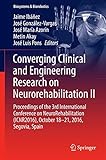Converging Clinical and Engineering Research on Neurorehabilitation II [electronic resource] : Proceedings of the 3rd International Conference on NeuroRehabilitation (ICNR2016), October 18-21, 2016, Segovia, Spain / edited by Jaime Ibáñez, José González-Vargas, José María Azorín, Metin Akay, José Luis Pons.
Contributor(s): Ibáñez, Jaime [editor.] | González-Vargas, José [editor.]
| González-Vargas, José [editor.] | Azorín, José María [editor.]
| Azorín, José María [editor.] | Akay, Metin [editor.]
| Akay, Metin [editor.] | Pons, José Luis [editor.]
| Pons, José Luis [editor.] | SpringerLink (Online service)
| SpringerLink (Online service) .
.
Material type:  BookSeries: Biosystems & Biorobotics: 15Publisher: Cham : Springer International Publishing : Imprint: Springer, 2017Edition: 1st ed. 2017.Description: XXXIII, 1507 p. 427 illus., 355 illus. in color. online resource.Content type: text Media type: computer Carrier type: online resourceISBN: 9783319466699.Subject(s): Biomedical engineering
BookSeries: Biosystems & Biorobotics: 15Publisher: Cham : Springer International Publishing : Imprint: Springer, 2017Edition: 1st ed. 2017.Description: XXXIII, 1507 p. 427 illus., 355 illus. in color. online resource.Content type: text Media type: computer Carrier type: online resourceISBN: 9783319466699.Subject(s): Biomedical engineeringFrom the table of contents: Part I: Characterization & Modulation of Neurophysiological Signals -- Part II: Empowering & Quantifying Neurorehabilitation -- Part III: Rehabilitation Robotics & Neuroprosthetics.
The book reports on advanced topics in the areas of neurorehabilitation research and practice. It focuses on new methods for interfacing the human nervous system with electronic and mechatronic systems to restore or compensate impaired neural functions. Importantly, the book merges different perspectives, such as the clinical, neurophysiological, and bioengineering ones, to promote, feed and encourage collaborations between clinicians, neuroscientists and engineers. Based on the 2016 International Conference on Neurorehabilitation (ICNR 2016) held on October 18-21, 2016, in Segovia, Spain, this book covers various aspects of neurorehabilitation research and practice, including new insights into biomechanics, brain physiology, neuroplasticity, and brain damages and diseases, as well as innovative methods and technologies for studying and/or recovering brain function, from data mining to interface technologies and neuroprosthetics. In this way, it offers a concise, yet comprehensive reference guide to neurosurgeons, rehabilitation physicians, neurologists, and bioengineers. Moreover, by highlighting current challenges in understanding brain diseases as well as in the available technologies and their implementation, the book is also expected to foster new collaborations between the different groups, thus stimulating new ideas and research directions.


There are no comments for this item.